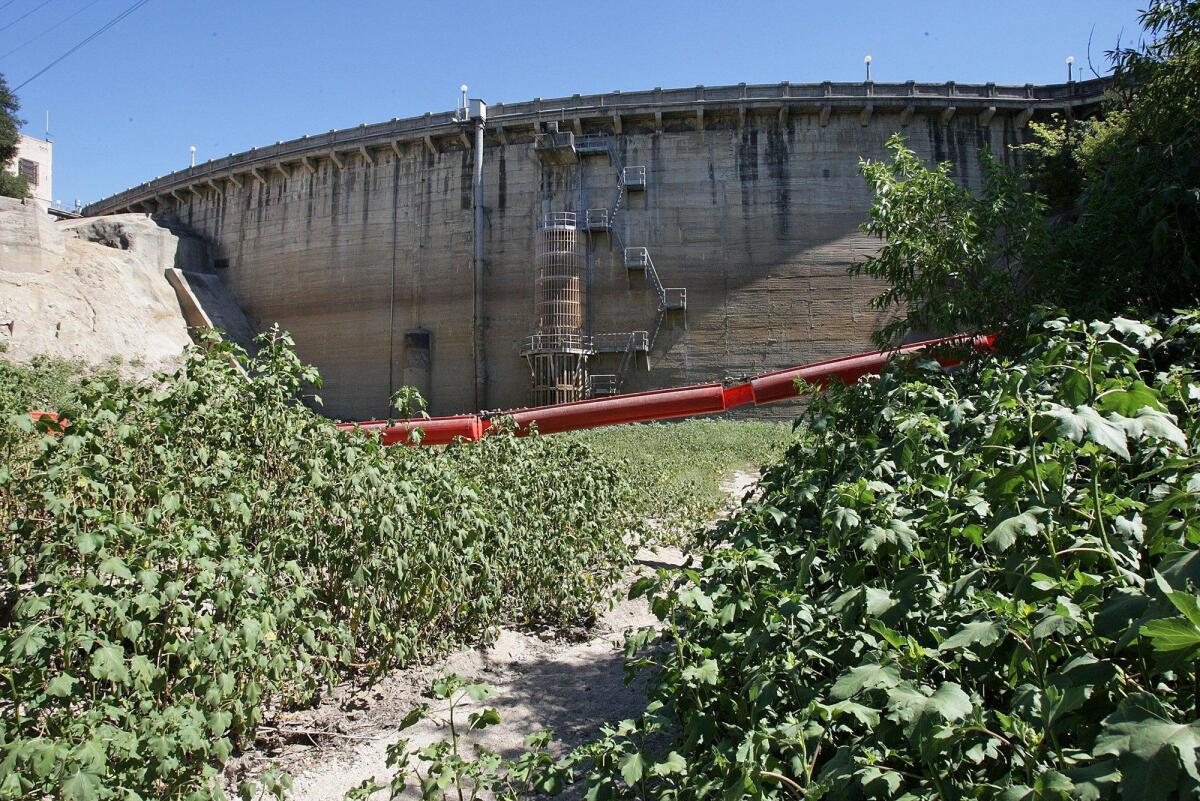County officials and conservationists still at odds as sediment-removal plan at Devil’s Gate Dam moves forward

A long boom spanning the holding area at Devil’s Gate Dam in the Hahamongna Watershed hangs in the air above a dry floor in this 2014 file photo.
As county officials advance plans to remove decades of built-up sediment from behind Devil’s Gate Dam, they and conservationists opposed to the project — whose view is shared by a candidate in the county supervisor’s race — held dueling informational sessions Saturday.
In an afternoon meeting at the Community Center of La Cañada Flintridge, county public works officials described a three- to five-year project that will involve up to 400 haul trips a day, amounting to 800 in-and-out truck trips daily along segments of Oak Grove Drive and Berkshire and Windsor avenues.
Officials shared concessions made to reduce health risks to nearby schools and job sites, including low-emission trucks with covered beds and time-sensitive hauling routes. A biologist consultant explained that to offset the impact of the dig on local wildlife experts would restore and replant a 70-acre portion of the land and remove invasive nonnative species that have flourished during years of neglect.
“The habitat out there is becoming degraded. Once an area gets taken over by these nonnative plants the diversity of native wildlife goes down,” said consultant Mari Quillman. “There are lots of things that can be done here to restore and make it better.”
Join the conversation on Facebook >>
But in a walking tour of Hahamongna held Saturday morning by the Arroyo Seco Foundation, one litigant in a 2014 lawsuit against the county, environmentalists aimed to show locals the richness and diversity that would be threatened by what they believe is an overzealous excavation plan.
Foundation members pointed out mulefat shrubs and black willow trees, the preferred environment of the federally endangered bird Least Bell’s vireo.
“Today we’re going to walk through the area,” member Nicholas Hernandez, a man of Southern California tribal descent who goes by the name Nicholas Hummingbird, told participants. “I want you to walk through it with the knowledge that this may be the last time you see the area as it is.”
Set between the Angeles National Forest and the Rose Bowl, Hahamongna Watershed Park plays an important role in moving stormwater from the San Gabriel Mountains through the Arroyo Seco to downtown Los Angeles and the L.A. River.
A sandy-bottomed flood basin behind the 96-year-old Devil’s Gate Dam is intended to prevent flooding to homes and cities downstream, but in the meantime supports a range of native plant and animal species and provides a rare wildlife corridor connecting the San Gabriel and San Rafael foothills.
For all its splendor, however, the current condition of Hahamongna’s stream bed is not ideal. Upwards of 4 million cubic yards of sediment have collected there as the result of decades of storm events, including a 2010 flood that brought tons of debris from the Station fire which preceded it.
Removing evidence of earlier upheavals and making Devil’s Gate and the land around it more effective at transporting water has been a stated priority of the county’s Flood Control District and is something with which many locals agree.
But exactly how to haul the sediment away — to what extent and for how long — and how to do so with minimal impact to indigenous wildlife habitats is at the center of the lawsuit between the county and environmentalists with the Arroyo Seco Foundation and Pasadena Audubon Society.
“This is not a natural sediment build up,” Tim Brick, managing director of the foundation, said during Saturday’s walk. “[The county] built the dam, and it’s the dam that trapped the sediment. They caused the problem and now they want to destroy the habitat to fix the problem they caused.”
Brick handed out “No Big Dig” T-shirts to about 30 walk participants. He encouraged them to attend the afternoon meeting, speak out and later share their concerns with Kathryn Barger and Darrell Park, the two candidates running to replace L.A. County Supervisor Mike Antonovich in the 5th District.
Residents and activists who turned out to the community center passionately shared their concerns and questions with Quillman, county engineer Keith Lilley and his colleagues.
“Our goal is that when all’s said and done, the overall quality of habitat in Hahamongna will be better than it is today,” Lilley told the crowd.
In a Q&A session, Democratic supervisorial candidate Park, who came into the meeting after its start, surprised the crowd with a bold suggestion.
“That sediment did not get there by trucks. That sediment got there by gravity and water, and that’s how we’re going to remove it,” Park said. “What nature wants to do, and what we stopped, it wants to flow down to the sea and help with beach restoration. That’s what we will do, and it will be far cheaper than what we’re doing now. We really, really, really need to rethink this.”
--
Sara Cardine, sara.cardine@latimes.com
Twitter: @SaraCardine
